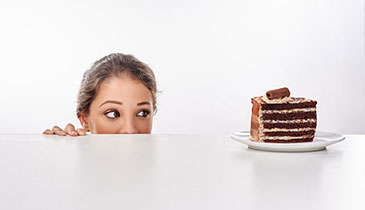 Source: Be Well
Source: Be Well
Have you ever noticed how when you’re short on sleep, stressed-out, or exhausted, you tend to crave carbs? Especially the crappy, nutrient-free variety that, under normal circumstances, you could easily resist?
Turns out that when it comes to cravings, your gut plays a far bigger role than previously thought and sheer willpower will not be enough to defeat them. So, how to loosen their steely grip and slay cravings for good? Here’s where to start:
Caving in to Cravings Isn’t a Failure of Willpower
Cravings are probably one of the most common barriers to maintaining a healthy weight and/or dropping extra pounds. They’re also adept at sabotaging your diet, so when you give in to them, poor choices and pangs of guilt are almost inevitable. But where do those craving come from? Why is it so hard to physically resist their siren call even though in our heads, we know better? Turns out, your brain isn’t solely driving your cravings. New research has shown that those thousands of bacterial strains—good, bad, or indifferent—that live in your gut are influencing your behavior. Some of them are driving cravings as an evolutionary survival mechanism, so you’d be wise to pay a lot more attention to the fuel you’re filling up on.
Sidestep the Cravings Creators
Inside your intestines, you’ve got trillions of bacteria—collectively known as the microbiome—that are sending messages to the brain. When you give them the wrong foods (like sugar and processed foods), the bacteria wind up sending unhealthy messages to your brain instead of healthy ones. However, when you eat a fiber-and-nutrient-dense food like broccoli, the bacteria feast on the fiber, digest it, and release a gas that goes right up to your brain (with help from the vagus nerve), essentially telling it that it’s been well-fed—no need for the cheesecake! So, simply put, if you avoid foods that generate the cravings messages, you’ll stop cravings before they start.
Your Belly’s Chatting with Your Brain
According to a recent study by the University of Glasgow and Imperial College of London, the foods you eat impact both the microbiome and your brain. This means that what you feed your belly bacteria matters even more than previously thought because it influences cravings, not to mention mood and emotions. It all starts with short-chain fatty acids (SCFAs), the chemicals that are made in the colon when you eat certain foods, particularly fiber (which, by the way, your helpful, or “good” gut bacteria, thrive on). Those SCFAs in your gut then send signals to your brain, and depending on what you’ve eaten, SCFAs activate feelings of satiety or trigger cravings.
In the study, when shown images of high-calorie foods, participants who ate foods that produced SCFAs showed a reduced area of activity in the reward centers of their brain—in other words, less craving. What’s more, participants also ate 10 percent less food, adding credence to the idea that SCFAs can play a role in supporting weight-control efforts.
Dig in to the Cravings Killers
So, to help kill cravings, you’ll need to feed your gut bacteria more of the foods that trigger SCFA production. Which foods will do the trick? The fiber-rich prebiotic ones that your body can’t digest on its own but your good gut bacteria loves to feast on—and breaks down into substances that help keep your body healthy, in balance, and less prone to cravings and blood-sugar crashes. Fortunately, those prebiotic edibles are easy-to-find, everyday staples like asparagus, artichokes, beans, broccoli, dandelion greens, garlic, jicama, leeks, and onions. To enjoy their crave-taming effects, shoot for one or two servings a day.
C’mon, Get Happy
Fiber goes beyond just curbing cravings: It can help boost your mood. It’s important to realize that all the brain neurochemicals, particularly serotonin and dopamine, are actually made in your gut. In fact, most of your serotonin—aka your body’s naturally occurring “feel-good” chemical—is made in the gut, not your brain. So again, getting more fiber into your gut has a profound positive effect on mood and emotional health. In other words, when you’re eating well and feeling good, cravings have considerably less power (or may not come up at all), versus when you’re eating poorly and producing few, if any, feel-good chemicals.
Manage Your Microbiome
Tired of cravings conning you into making lousy food choices? Then push back and show ’em who’s boss. Follow this crave-curbing road map and before you know it, you’ll be on easy street —and you may even drop a few pounds to boot:
– Get into fiber—ideally, at least 30 grams a day, but if you’ve not been eating much fiber, integrate it into your diet slowly to give your body time to adjust.
– Spread it out throughout the day—shooting for roughly 10 grams of fiber per meal is an easy way to get you to think about where to sneak more fiber into your daily diet.
– Pile on fiber-rich prebiotics—foods like asparagus, artichokes, beans, broccoli, dandelion greens, garlic, jicama, leeks, and onions will curb cravings. Low-fiber foods will have the opposite effect.
– Hang onto your stalks and stems—never cut them off! Think of them as the ultimate fiber-loaded treat for your good bacteria, so let the bugs feast, as frequently as possible!
– Take a probiotic—a good quality probiotic can help restore and sustain the beneficial gut flora that keeps your microbiome healthy and in balance
– Balance meals and snacks—every time you eat, make sure there’s a balance of fiber, protein, and good fat on your plate to fill you up, give your gut bacteria plenty of fiber to feed on, prevent cravings, and keep blood sugar stable.
– Hold the sugar—when you stop eating sugar-packed foods, cravings retreat, so ditch processed foods and baked goods, which are loaded with sugar—and devoid of the fiber your microbiome needs to prevent cravings.
– Cast a wide culinary net—don’t get stuck in a rut eating the same healthy foods all the time. A more diverse, nutrient- and fiber-rich diet will give your microbiome healthier material to work with, which in turn will tamp down cravings and help keep immunity strong.
– Remember who’s boss—yes, the bacteria in your gut are manipulating cravings, mood, and emotional health, but ultimately you are in charge of how you feed them. My recommendation? Take care of your bacteria with nutrient- and fiber-dense foods at every meal—and they’ll take care of you.




